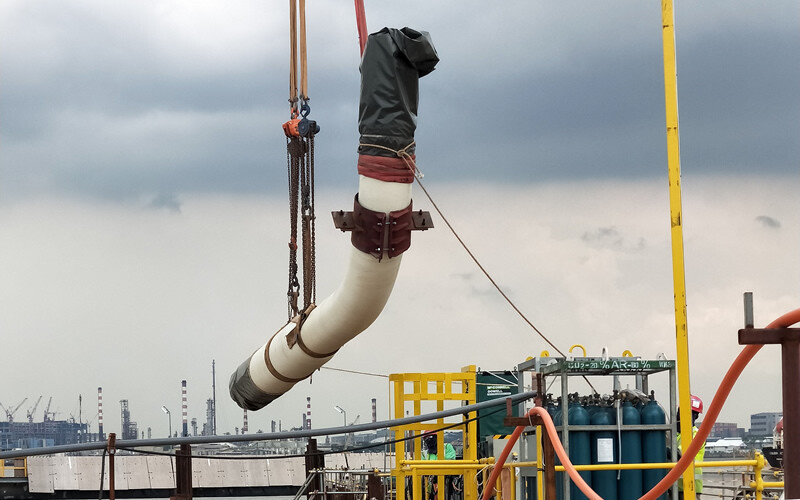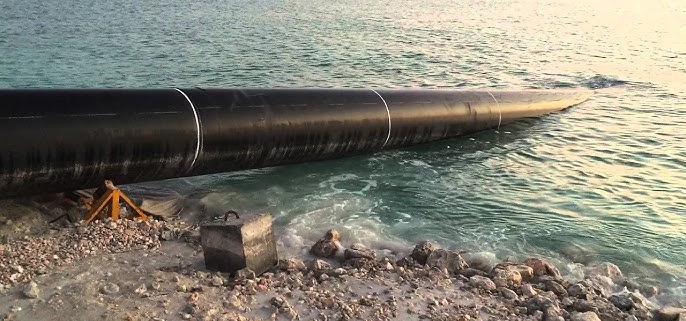ท่อส่งน้ำมันใต้ทะเล: การสำรวจเชิงลึก
การแนะนำ
ท่อส่งน้ำมันและก๊าซสำหรับเรือดำน้ำขนส่งน้ำมัน ก๊าซ และของเหลวอื่นๆ ข้ามระยะทางใต้น้ำที่ไกลมาก ท่อส่งเหล่านี้มีความจำเป็นสำหรับการเชื่อมต่อแท่นขุดเจาะน้ำมันและก๊าซนอกชายฝั่งกับสิ่งอำนวยความสะดวกบนชายฝั่ง ทำให้สามารถถ่ายโอนทรัพยากรจากสถานที่ห่างไกลไปยังตลาดโลกได้อย่างมีประสิทธิภาพและปลอดภัย อย่างไรก็ตาม การออกแบบ ก่อสร้าง และบำรุงรักษาท่อส่งน้ำมันและก๊าซสำหรับเรือดำน้ำเป็นความท้าทายที่ไม่เหมือนใครเนื่องจากสภาพแวดล้อมทางทะเลที่รุนแรงและเปลี่ยนแปลงตลอดเวลา บล็อกนี้จะให้ภาพรวมที่ครอบคลุมเกี่ยวกับท่อส่งน้ำมันและก๊าซสำหรับเรือดำน้ำ รวมถึงการใช้งาน ข้อควรพิจารณาในการออกแบบ วัสดุ วิธีการติดตั้ง และกลยุทธ์การบำรุงรักษา
1. บทบาทของท่อส่งใต้น้ำในอุตสาหกรรมพลังงาน
1.1 ความสำคัญของท่อส่งน้ำมันใต้น้ำ
ท่อส่งน้ำมันใต้ทะเลถือเป็นเส้นเลือดใหญ่ของอุตสาหกรรมน้ำมันและก๊าซนอกชายฝั่ง ท่อส่งน้ำมันใต้ทะเลเป็นเส้นทางตรงและปลอดภัยในการขนส่งไฮโดรคาร์บอนจากแหล่งน้ำมันนอกชายฝั่งไปยังโรงกลั่นและโรงงานแปรรูปบนบก ท่อส่งน้ำมันใต้ทะเลมีความจำเป็นต่อห่วงโซ่อุปทานพลังงานทั่วโลก โดยเฉพาะอย่างยิ่งเมื่อความต้องการน้ำมันและก๊าซเพิ่มมากขึ้น
1.2 แอปพลิเคชันหลัก
การขนส่งน้ำมันและก๊าซ: ท่อส่งใต้น้ำส่วนใหญ่ใช้เพื่อขนส่งน้ำมันดิบ ก๊าซธรรมชาติ และคอนเดนเสตจากแท่นผลิตนอกชายฝั่งไปยังโรงงานบนชายฝั่งเพื่อการแปรรูปและการจัดจำหน่าย
ท่อฉีดน้ำ: ในการปฏิบัติการกู้คืนน้ำมันขั้นสูง (EOR) ท่อส่งใต้น้ำจะฉีดน้ำเข้าไปในอ่างเก็บน้ำเพื่อรักษาแรงดันและปรับปรุงอัตราการกู้คืนน้ำมัน
สายสะดือใต้ทะเล: ท่อส่งแบบพิเศษเหล่านี้ขนส่งของเหลวควบคุม ไฟฟ้า และสัญญาณการสื่อสารระหว่างอุปกรณ์ใต้น้ำและสิ่งอำนวยความสะดวกบนผิวน้ำ
2. ข้อควรพิจารณาในการออกแบบท่อส่งน้ำมันใต้น้ำ
2.1 ปัจจัยด้านสิ่งแวดล้อมและธรณีเทคนิค
สิ่งแวดล้อมทางทะเล: ท่อส่งน้ำสำหรับเรือดำน้ำต้องได้รับการออกแบบให้ทนทานต่อการกัดกร่อนของน้ำทะเล กระแสน้ำที่แรง และผลกระทบที่อาจเกิดขึ้นจากเรือหรือวัตถุต่างๆ ในทะเล นอกจากนี้ อุณหภูมิและแรงดันที่พื้นทะเลยังส่งผลต่อการเลือกใช้วัสดุและการออกแบบท่อส่งน้ำด้วย
ลักษณะภูมิประเทศของพื้นท้องทะเล: ลักษณะภูมิประเทศของพื้นทะเล รวมถึงความลาดชัน หุบเขา และร่องลึก ส่งผลต่อการวางท่อส่งน้ำมันและความเสถียรของท่อ การสำรวจทางธรณีเทคนิคมีความจำเป็นในการประเมินสภาพพื้นทะเลและกำหนดเส้นทางวางท่อที่ดีที่สุด
กิจกรรมแผ่นดินไหว: ในภูมิภาคที่มีความเสี่ยงต่อแผ่นดินไหว ท่อส่งใต้น้ำจะต้องได้รับการออกแบบให้รองรับการเคลื่อนตัวของพื้นดินและป้องกันความเสียหายจากเหตุการณ์แผ่นดินไหว
2.2 ความสมบูรณ์และความปลอดภัยของท่อส่ง
การเลือกใช้วัสดุ: ท่อส่งน้ำสำหรับเรือดำน้ำโดยทั่วไปสร้างขึ้นจากเหล็กกล้าคาร์บอนที่มีความแข็งแรงสูง เคลือบด้วยวัสดุป้องกันการกัดกร่อน เช่น อีพอกซีเชื่อมติดแบบฟิวชั่น (FBE) หรือโพลีเอทิลีนสามชั้น (3LPE) เพื่อป้องกันการกัดกร่อนและความเสียหายทางกล
เสถียรภาพของท่อส่ง: ความเสถียรถือเป็นปัญหาสำคัญ โดยเฉพาะในพื้นที่ที่มีกระแสน้ำแรงหรือพื้นท้องทะเลที่ไม่เรียบ เทคนิคต่างๆ เช่น การขุดร่อง ฝัง หรือเพิ่มน้ำหนักคอนกรีตเคลือบท่อ จะช่วยรักษาเสถียรภาพของท่อได้
ระบบตรวจจับการรั่วไหล: ท่อส่งใต้น้ำติดตั้งระบบตรวจจับการรั่วไหลขั้นสูงที่ตรวจสอบความดัน อัตราการไหล และพารามิเตอร์อื่นๆ แบบเรียลไทม์ เพื่อตรวจจับการรั่วไหลหรือความผิดปกติ

ท่อส่งน้ำใต้ทะเลหรือท่อส่งน้ำใต้ทะเล
3. วัสดุที่ใช้ในการก่อสร้างท่อส่งน้ำใต้ทะเล
3.1 เหล็กกล้าคาร์บอน
เหล็กกล้าคาร์บอนเป็นวัสดุที่นิยมใช้มากที่สุดในท่อส่งน้ำสำหรับเรือดำน้ำ เนื่องจากมีความแข็งแรง ทนทาน และคุ้มต้นทุน โดยทั่วไปแล้วเหล็กกล้าคาร์บอนจะเคลือบด้วยชั้นป้องกันการกัดกร่อนเพื่อป้องกันสภาพแวดล้อมทางทะเลที่รุนแรง
3.2 โลหะผสมที่ทนต่อการกัดกร่อน (CRA)
ในพื้นที่ที่ท่อต้องสัมผัสกับของเหลวที่มีฤทธิ์กัดกร่อนสูง เช่น ก๊าซที่มีกลิ่นเปรี้ยวหรือน้ำทะเล จะใช้โลหะผสมที่ทนต่อการกัดกร่อน เช่น สเตนเลสสตีล สเตนเลสสตีลดูเพล็กซ์ หรืออินโคเนล วัสดุเหล่านี้มีความทนทานต่อการกัดกร่อนดีเยี่ยมและมีความแข็งแรงเชิงกลสูง
3.3 ระบบการเคลือบ
อีพอกซีเชื่อมฟิวชั่น (FBE): สารเคลือบ FBE ช่วยป้องกันการกัดกร่อนได้ดีเยี่ยม และมักใช้กับท่อส่งใต้น้ำ
โพลีเอทิลีนสามชั้น (3LPE): สารเคลือบ 3LPE ประกอบด้วยไพรเมอร์อีพอกซี กาวโพลีเมอร์ และสารเคลือบด้านบนโพลีเอทิลีน ซึ่งให้การปกป้องเชิงกลและความทนทานต่อการกัดกร่อนที่เหนือกว่า
การเคลือบน้ำหนักคอนกรีต: การเคลือบด้วยน้ำหนักคอนกรีตมักใช้เพื่อให้มั่นใจถึงความเสถียรและปกป้องท่อจากความเสียหายจากภายนอก โดยเฉพาะในบริเวณที่มีกระแสน้ำแรง หรือบริเวณที่วางท่อบนพื้นทะเล
4. วิธีการติดตั้ง
4.1 วิธีการวาง S
วิธีการวางท่อส่งใต้น้ำแบบ S-lay ถือเป็นเทคนิคที่ใช้กันทั่วไปที่สุดวิธีหนึ่ง โดยจะเชื่อมท่อเข้ากับเรือบรรทุกวางท่อ แล้วค่อย ๆ ปล่อยลงสู่พื้นทะเลในลักษณะโค้งเป็นรูปตัว S วิธีนี้เหมาะสำหรับความลึกของน้ำตื้นถึงปานกลาง
4.2 วิธีการ J-Lay
ในวิธีการวางท่อแบบ J-lay ท่อจะถูกวางในแนวตั้งลงไปในน้ำและวางในแนวนอนบนพื้นทะเล เทคนิคนี้เหมาะอย่างยิ่งสำหรับการติดตั้งในน้ำลึก เนื่องจากช่วยลดความเครียดที่เกิดขึ้นกับท่อระหว่างขั้นตอนการวางท่อ
4.3 วิธีการวางม้วน
วิธีการวางท่อแบบม้วนเป็นวิธีการม้วนท่อเข้าในม้วนใหญ่แล้วจึงคลายออกในระหว่างการติดตั้ง วิธีการที่รวดเร็วและมีประสิทธิภาพนี้ทำให้เหมาะสำหรับท่อขนาดสั้นหรือการติดตั้งในสถานที่ห่างไกล
4.4 การขุดร่องและฝังดิน
ในพื้นที่ที่มีความเสี่ยงต่อสิ่งแวดล้อมสูงหรือในพื้นที่ที่ความมั่นคงของพื้นทะเลเป็นปัญหา ท่อจะถูกฝังไว้ในร่องลึกเพื่อให้การป้องกันเพิ่มเติมจากแรงภายนอก การขุดร่องลึกสามารถทำได้โดยใช้คันไถ เครื่องฉีดน้ำ หรือเครื่องขุดร่องลึกแบบกลไก
5. การจัดการการบำรุงรักษาและความสมบูรณ์
5.1 เทคนิคการตรวจสอบ
การตรวจสอบในสายการผลิต (ILI): เครื่องมือ ILI หรือที่เรียกกันทั่วไปว่า “หมูอัจฉริยะ” ใช้ตรวจสอบสภาพภายในท่อส่งน้ำใต้ทะเล เครื่องมือเหล่านี้สามารถตรวจจับการกัดกร่อน รอยแตกร้าว และความผิดปกติอื่นๆ ที่อาจทำให้ท่อไม่แข็งแรง
การตรวจสอบ ROV และ AUV: ยานยนต์ควบคุมระยะไกล (ROV) และยานยนต์ใต้น้ำไร้คนขับ (AUV) ตรวจสอบสภาพภายนอกของท่อส่งน้ำมันใต้ทะเล ยานยนต์เหล่านี้มีกล้องและเซ็นเซอร์เพื่อตรวจสอบสภาพของท่อส่งน้ำมันและระบุปัญหาที่อาจเกิดขึ้น
5.2 การตรวจสอบการกัดกร่อน
การป้องกันแคโทด: ระบบป้องกันแคโทดิกช่วยป้องกันการกัดกร่อนบนพื้นผิวภายนอกของท่อส่งน้ำใต้ทะเล ระบบเหล่านี้ใช้ขั้วบวกหรือกระแสไฟฟ้าที่ไหลผ่านเพื่อป้องกันท่อส่งน้ำจากน้ำทะเลที่กัดกร่อน
สารยับยั้งการกัดกร่อน: ในบางกรณี สารยับยั้งการกัดกร่อนจะถูกฉีดเข้าไปในท่อเพื่อป้องกันพื้นผิวภายในจากของเหลวที่กัดกร่อน
5.3 การตรวจจับการรั่วไหลและการตอบสนองฉุกเฉิน
การตรวจสอบแบบเรียลไทม์: ท่อส่งน้ำใต้ทะเลมีระบบตรวจสอบแบบเรียลไทม์ที่ตรวจจับการรั่วไหล ความดันลดลง และความผิดปกติอื่นๆ การตรวจจับแต่เนิ่นๆ ถือเป็นสิ่งสำคัญในการป้องกันความเสียหายต่อสิ่งแวดล้อมและรับรองความปลอดภัยของท่อส่งน้ำ
แผนการตอบสนองต่อเหตุฉุกเฉิน: มีแผนตอบสนองฉุกเฉินที่ครอบคลุมเพื่อจัดการกับการรั่วไหลหรือการแตกที่อาจเกิดขึ้นในท่อส่งน้ำมันใต้ทะเล แผนดังกล่าวรวมถึงขั้นตอนการปิดท่อส่งน้ำมัน การควบคุมการรั่วไหล และการบรรเทาผลกระทบต่อสิ่งแวดล้อม
6. บทสรุป: อนาคตของท่อส่งใต้น้ำ
เนื่องจากความต้องการพลังงานยังคงเพิ่มขึ้นอย่างต่อเนื่อง จึงไม่สามารถมองข้ามความสำคัญของท่อส่งใต้น้ำในห่วงโซ่อุปทานพลังงานทั่วโลกได้ ความก้าวหน้าในด้านวัสดุ เทคนิคการติดตั้ง และการจัดการความสมบูรณ์ช่วยเพิ่มความน่าเชื่อถือและความปลอดภัยของโครงสร้างพื้นฐานที่สำคัญเหล่านี้ อย่างไรก็ตาม ความท้าทายที่เกิดขึ้นอย่างต่อเนื่อง เช่น การกัดกร่อน ผลกระทบต่อสิ่งแวดล้อม และการติดตั้งในน้ำลึก จำเป็นต้องมีนวัตกรรมและการปรับปรุงอย่างต่อเนื่อง
จากการเข้าใจถึงความซับซ้อนของท่อส่งใต้น้ำและการนำแนวทางปฏิบัติที่ดีที่สุดในการออกแบบ การก่อสร้าง และการบำรุงรักษามาใช้ อุตสาหกรรมจึงสามารถรับประกันการขนส่งทรัพยากรจากแหล่งนอกชายฝั่งสู่ตลาดทั่วโลกได้อย่างปลอดภัยและมีประสิทธิภาพ
7. คำถามที่พบบ่อย
คำถามที่ 1: ความท้าทายหลักในการก่อสร้างท่อส่งใต้น้ำคืออะไร?
ความท้าทายหลักๆ ได้แก่ ปัจจัยด้านสิ่งแวดล้อม เช่น การกัดกร่อน กระแสน้ำที่แรง ความเสถียรของก้นทะเล และความท้าทายทางเทคนิคที่เกี่ยวข้องกับการเลือกวัสดุ วิธีการติดตั้ง และการดูแลรักษาความสมบูรณ์ของท่อในระยะยาว
คำถามที่ 2: ท่อส่งใต้น้ำได้รับการปกป้องจากการกัดกร่อนอย่างไร?
ท่อส่งใต้น้ำได้รับการปกป้องจากการกัดกร่อนด้วยการใช้สารเคลือบป้องกันการกัดกร่อน เช่น FBE และ 3LPE ระบบป้องกันแคโทดิก และวัสดุที่ทนทานต่อการกัดกร่อนในสภาพแวดล้อมที่มีฤทธิ์กัดกร่อนสูง
คำถามที่ 3: การตรวจสอบแบบเรียลไทม์ในท่อส่งน้ำใต้น้ำมีความสำคัญอย่างไร?
การตรวจสอบแบบเรียลไทม์มีความสำคัญอย่างยิ่งในการตรวจจับการรั่วไหล การลดลงของแรงดัน และความผิดปกติอื่นๆ ที่อาจส่งผลต่อความสมบูรณ์ของท่อ การตรวจจับแต่เนิ่นๆ ช่วยให้ตอบสนองและบรรเทาปัญหาได้อย่างรวดเร็ว ป้องกันความเสียหายต่อสิ่งแวดล้อม และรับรองความปลอดภัยของท่อ




